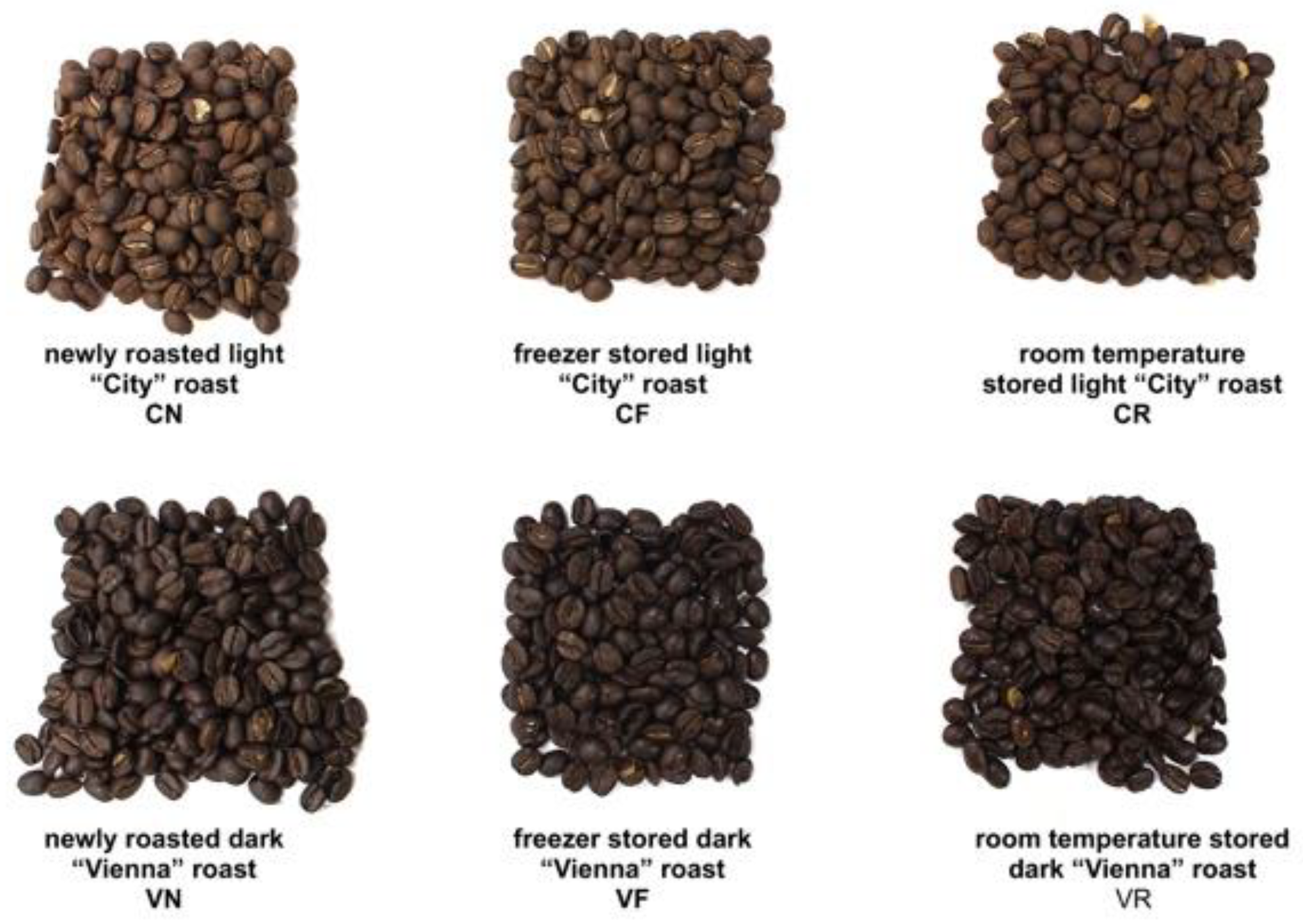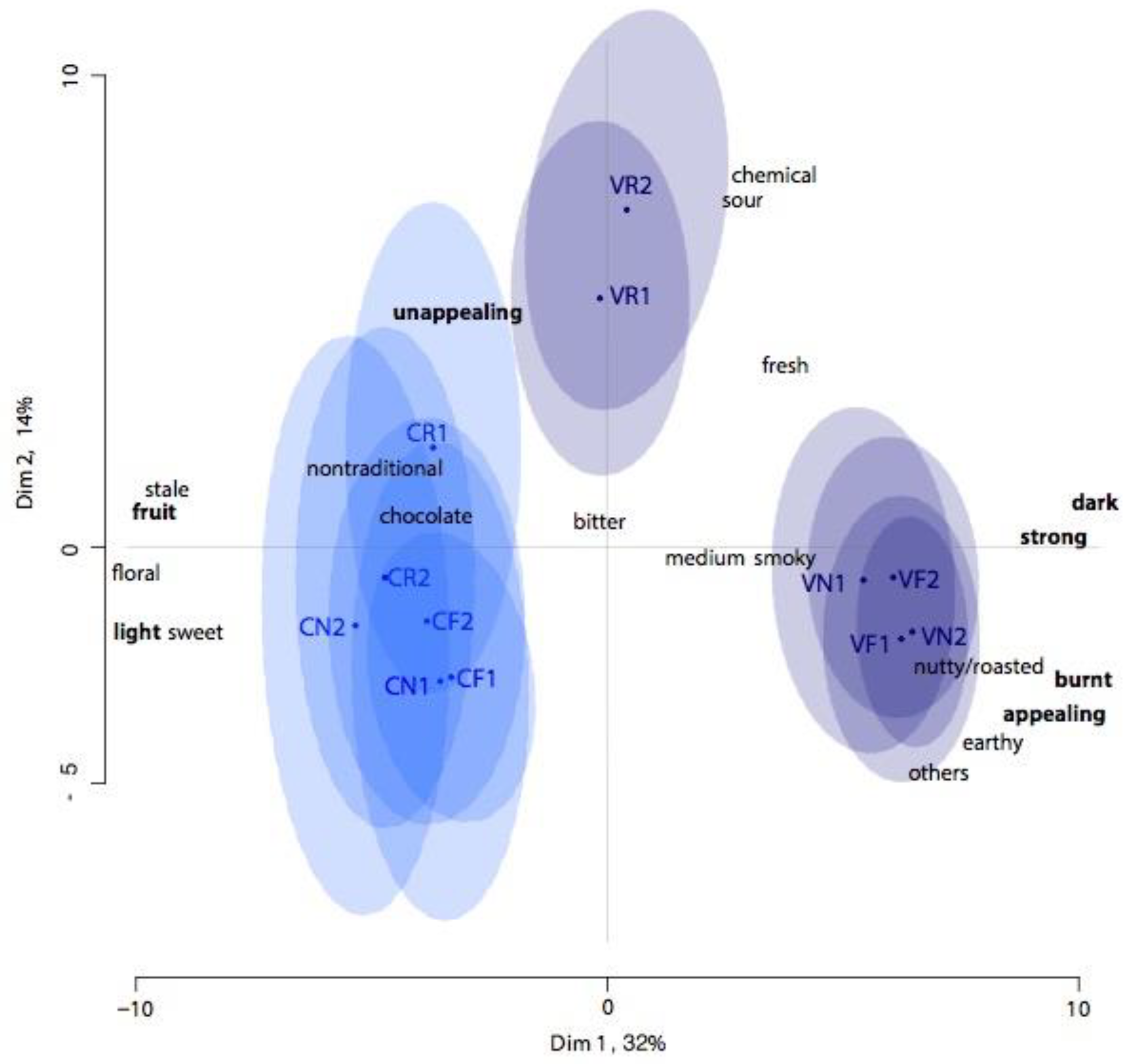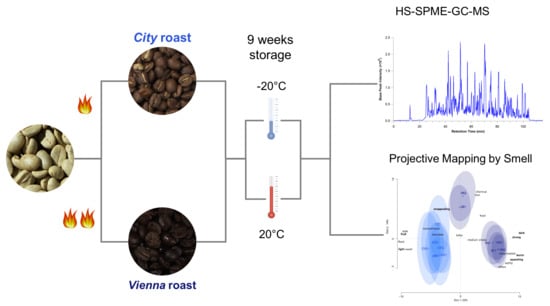The Effects of Storage Temperature on the Aroma of Whole Bean Arabica Coffee Evaluated by Coffee Consumers and HS-SPME-GC-MS
Abstract
:1. Introduction
2. Materials and Methods
2.1. Experimental Design
2.2. Roasting and Storage Conditions
2.3. Sensory Analysis
“In front of you are 12 samples of ground coffee beans. Your task is to evaluate the aroma (smelling ONLY) of each sample according to your own criteria. There are no right or wrong answers. For each sample, remove the lid and smell the contents of the glass. You may take notes about the aroma of each sample on the notepad provided. Once you have smelled each sample, place the glasses on the large paper in front of you in a manner that positions very similar smelling samples close to each other: the more similar the samples, the closer they should be to one-another. You may group samples together if they smell very similar or the same. Samples that are very different should be placed far apart. Do not hesitate to make use of the entire area of the sheet provided. There are no restrictions as to the size of the groups or the total number of groups you make.”
2.4. Instrumental Analysis with HS-SPME-GC-MS
2.5. Data Analysis
3. Results
3.1. Coffee Consumers Group Identical Samples and Separate Coffees Based on Roast Level and Storage Condition
3.2. Coffee Consumers Are Able to Describe Aroma Differences That Reflect Changes in Aroma Composition
3.3. Instrumental Volatile Analysis Separates Coffees Based on Roast Level and Storage Conditions
4. Discussion and Conclusions
Supplementary Materials
Author Contributions
Funding
Acknowledgments
Conflicts of Interest
References
- Sunarharum, W.B.; Williams, D.J.; Smyth, H.E. Complexity of coffee flavor: A compositional and sensory perspective. Food Res. Int. 2014, 62, 315–325. [Google Scholar] [CrossRef]
- Blank, I.; Sen, A.; Grosch, W. Potent odorants of the roasted powder and brew of Arabica coffee. Z. Lebensm. Unters. Forsch. 1992, 195, 239–245. [Google Scholar] [CrossRef]
- López-Galilea, I.; Fournier, N.; Cid, C.; Guichard, E. Changes in headspace volatile concentrations of coffee brews caused by the roasting process and the brewing procedure. J. Agric. Food Chem. 2006, 54, 8560–8566. [Google Scholar] [CrossRef] [PubMed]
- Anese, M.; Manzocco, L.; Nicoli, M.C. Modeling the secondary shelf life of ground roasted coffee. J. Agric. Food Chem. 2006, 54, 5571–5576. [Google Scholar] [CrossRef] [PubMed]
- Bröhan, M.; Huybrighs, T.; Wouters, C.; Van der Bruggen, B. Influence of storage conditions on aroma compounds in coffee pads using static headspace GC-MS. Food Chem. 2009, 116, 480–483. [Google Scholar] [CrossRef]
- Yeretzian, C.; Blank, I.; Wyser, Y. Protecting the flavors-freshness as a key to quality. In The Craft and Science of Coffee; Britta, F., Ed.; Academic Press: Cambridge, MA, USA, 2017. [Google Scholar]
- Maeztu, L.; Sanz, C.; Andueza, S.; Paz De Peña, M.; Bello, J.; Cid, C. Characterization of espresso coffee aroma by static headspace GC-MS and sensory flavor profile. J. Agric. Food Chem. 2001, 49, 5437–5444. [Google Scholar] [CrossRef] [PubMed]
- Marin, K.; Požrl, T.; Zlatić, E.; Plestenjak, A. A new aroma index to determine the aroma quality of roasted and ground coffee during storage. Food Technol. Biotechnol. 2008, 46, 442–447. [Google Scholar]
- Yeretzian, C. Coffee. In Springer Handbook of Odor; Springer: Cham, Switzerland, 2017; pp. 107–128. [Google Scholar]
- Kreuml, M.T.L.; Majchrzak, D.; Ploederl, B.; Koenig, J. Changes in sensory quality characteristics of coffee during storage. Food Sci. Nutr. 2013, 1, 267–272. [Google Scholar] [CrossRef] [PubMed] [Green Version]
- Glöss, A.N.; Schönbächler, B.; Rast, M.; Deuber, L.; Yeretzian, C. Freshness indices of roasted coffee: Monitoring the loss of freshness for single serve capsules and roasted whole beans in different packaging. Chimia 2014, 68, 179–182. [Google Scholar] [CrossRef] [PubMed]
- Risvik, E.; McEwan, J.A.; Rødbotten, M. Evaluation of sensory profiling and projective mapping data. Food Qual. Prefer. 1997, 8, 63–71. [Google Scholar] [CrossRef]
- Hopfer, H.; Heymann, H. A summary of projective mapping observations—The effect of replicates and shape, and individual performance measurements. Food Qual. Prefer. 2013, 28, 164–181. [Google Scholar] [CrossRef]
- Nestrud, M.A.; Lawless, H.T. Perceptual mapping of citrus juices using projective mapping and profiling data from culinary professionals and consumers. Food Qual. Prefer. 2008, 19, 431–438. [Google Scholar] [CrossRef]
- Heymann, H.; Hopfer, H.; Bershaw, D. An exploration of the perception of minerality in white wines by projective mapping and descriptive analysis. J. Sens. Stud. 2014, 29, 1–13. [Google Scholar] [CrossRef]
- Cruz, A.G.; Cadena, R.S.; Castro, W.F.; Esmerino, E.A.; Rodrigues, J.B.; Gaze, L.; Faria, J.A.F.; Freitas, M.Q.; Deliza, R.; Bolini, H.M.A. Consumer perception of probiotic yogurt: Performance of check all that apply (CATA), projective mapping, sorting and intensity scale. Food Res. Int. 2013, 54, 601–610. [Google Scholar] [CrossRef]
- Mielby, L.H.; Hopfer, H.; Jensen, S.; Thybo, A.K.; Heymann, H. Comparison of descriptive analysis, projective mapping and sorting performed on pictures of fruit and vegetable mixes. Food Qual. Prefer. 2014, 35, 86–94. [Google Scholar] [CrossRef]
- Kostov, B.; Bécue-Bertaut, M.; Husson, F. Multiple factor analysis for contingency tables in the FactoMineR package. Rencontres 2013, 5, 29–38. [Google Scholar]
- Dehlholm, C.; Brockhoff, P.B.; Bredie, W.L.P. Confidence ellipses: A variation based on parametric bootstrapping applicable on Multiple Factor Analysis results for rapid graphical evaluation. Food Qual. Prefer. 2012, 26, 278–280. [Google Scholar] [CrossRef]
- Le, S.; Husson, F. Sensominer: A package for sensory data analysis. J. Sens. Stud. 2008, 23, 14–25. [Google Scholar] [CrossRef]
- Giacalone, D.; Ribeiro, L.; Frøst, M. Perception and description of premium beers by panels with different degrees of product expertise. Beverages 2016, 2, 5. [Google Scholar] [CrossRef] [Green Version]
- Lê, S.; Josse, J.; Husson, F. FactoMineR: An R package for multivariate analysis. J. Stat. Softw. 2008, 25, 1–18. [Google Scholar] [CrossRef]
- De Mendiburu, F. Agricolae: Statistical Procedures for Agricultural Research. Available online: https://cran.r-project.org/package=agricolae (accessed on 5 February 2018).
- Maxime, H. RVAideMemoire: Diverse Basic Statistical and Graphical Functions. 2016. Available online: https://CRAN.R-project.org/package=RVAideMemoire (accessed on 15 March 2018).
- Rozin, P. “Taste-smell confusions” and the duality of the olfactory sense. Percept. Psychophys. 1982, 31, 397–401. [Google Scholar] [CrossRef] [PubMed] [Green Version]
- Stevenson, R.J.; Prescott, J.; Boakes, R.A. Confusing tastes and smells: How odours can influence the perception of sweet and sour tastes. Chem. Senses 1999, 24, 627–635. [Google Scholar] [CrossRef] [PubMed]
- Yang, N.; Liu, C.; Liu, X.; Degn, T.K.; Munchow, M.; Fisk, I. Determination of volatile marker compounds of common coffee roast defects. Food Chem. 2016, 211, 206–214. [Google Scholar] [CrossRef] [PubMed]
- Torri, L.; Dinnella, C.; Recchia, A.; Naes, T.; Tuorila, H.; Monteleone, E. Projective Mapping for interpreting wine aroma differences as perceived by naïve and experienced assessors. Food Qual. Prefer. 2013, 29, 6–15. [Google Scholar] [CrossRef] [Green Version]



© 2018 by the authors. Licensee MDPI, Basel, Switzerland. This article is an open access article distributed under the terms and conditions of the Creative Commons Attribution (CC BY) license (http://creativecommons.org/licenses/by/4.0/).
Share and Cite
Cotter, A.R.; Hopfer, H. The Effects of Storage Temperature on the Aroma of Whole Bean Arabica Coffee Evaluated by Coffee Consumers and HS-SPME-GC-MS. Beverages 2018, 4, 68. https://0-doi-org.brum.beds.ac.uk/10.3390/beverages4030068
Cotter AR, Hopfer H. The Effects of Storage Temperature on the Aroma of Whole Bean Arabica Coffee Evaluated by Coffee Consumers and HS-SPME-GC-MS. Beverages. 2018; 4(3):68. https://0-doi-org.brum.beds.ac.uk/10.3390/beverages4030068
Chicago/Turabian StyleCotter, Andrew R., and Helene Hopfer. 2018. "The Effects of Storage Temperature on the Aroma of Whole Bean Arabica Coffee Evaluated by Coffee Consumers and HS-SPME-GC-MS" Beverages 4, no. 3: 68. https://0-doi-org.brum.beds.ac.uk/10.3390/beverages4030068





